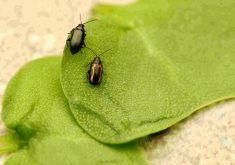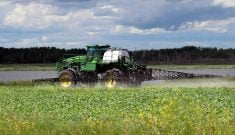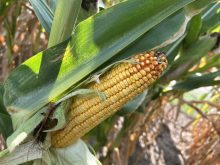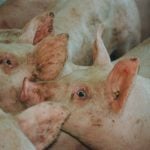It’s time to put Manitoba on the map — the risk map for pea leaf weevil, that is.
Manitoba is the last Prairie province to get the pest, but the province’s bug experts and pulse specialists know it’s lurking. Not only that, according to Laura Schmidt, production specialist with the Manitoba Pulse and Soybean Growers (MPSG), but it’s spreading.
“Last year, in the fall time, sweeping fababean fields as well as just checking pea regrowth, we were able to find quite a few adult pea leaf weevils heading into the winter — more than we were expecting,” she said.
Read Also

Seeding Indigenous agricultural prosperity
National Circle for Indigenous Agriculture and Food says Indigenous agricultural success needs strong relationships.
“They’ve really expanded their range in Manitoba. We were finding them as far east as Holland and Gladstone, where previously we’d really only found them in Dauphin and Swan River.”
Why it matters: The history of pea leaf weevil in Manitoba is only a few years old, but long-term weather averages suggest that the province might provide fertile ground for the pest to become established.
The MPSG is calling producers to volunteer their pea and fababean fields for monitoring. Agronomists from the organization have teamed up with those from Manitoba Agriculture and several private firms to administer the survey.
Schmidt noted that the data will then inform their knowledge on the scope and range of Manitoba’s pea leaf weevil problems, as well as give better information for producers trying to decide if a seed treatment needs to be added into their future plans.
Surveys are fairly quick, she noted, since signs are mostly noted along the field edge.
About 15 to 20 fields are currently being monitored.
Recent problem
The weevil first encroached on Manitoba in 2019.
First sightings of pea leaf weevil were found in the northwest when a late-season scouting agronomist spotted weevil adults, according to provincial entomologist John Gavloski.

Reports sparked the first official surveys of pea leaf weevil. Over the next years, pit fall traps found additional evidence of the insect in the northwest.
“We probably, for a while, had it without even realizing we had it,” Gavloski said.
The sightings toppled Manitoba’s status as the last remaining Prairie province where pea leaf weevil had not yet spread. The pest had previously cropped up in Alberta, starting in 2000. By 2007, entomologists in Saskatchewan had also confirmed the presence of the weevil.
Manitoba may, however, also be the friendliest habitat for the pest.
Gavloski pointed to a model developed by Agriculture and Agri-Food Canada, which outlined the survivability of pea leaf weevil based on a region’s historical weather. That model, he noted, suggested that the weevils fared better in areas with more historical precipitation and soil moisture.
“The expectation is that they should survive quite well here,” Gavloski said. “Probably, we’ll see populations go up and down based on both weather and, potentially, natural enemies.”
Associated with that, he noted, the province’s recent spate of dry years likely helped suppress weevil levels for the last few seasons.
Control challenges
One issue, Gavloski noted, is the inherent trickiness of pea leaf weevil control.
Although leaf notching is a sure sign of the weevil, economic damage to a crop happens earlier in the insect’s life cycle, below ground and out of reach of foliar application. Pea leaf weevil larvae feed on root nodules, therefore depriving plants of nitrogen.

Even looking at proactive control for future seasons, Gavloski said, seed treatment options on the market are imperfect.
“They do help somewhat, but they’re not completely effective,” he said.
Foliar control of adults, meanwhile, hits issues because of multiple waves of migration into the field and variations in spring emergence, Schmidt said.
Adult weevil sightings will bookend the growing season, according to Gavloski. The insects overwinter as adults, emerging to reinfest a field come spring.
Weather, again, will be a “driving factor” in how well the levels of fall adults will translate into a pea leaf weevil problem the following year, Gavloski said.
“If we get a series of dry years, like we’ve had, that could help keep the populations subeconomic and a bit lower. If they get a bit of more favourable years, that could help build populations up,” he said.
That has played out in pea leaf weevil outlooks across the Prairies, he noted. Risk maps published by AAFC showed little leaf notching through most of Saskatchewan, eastern Alberta and the Grande Prairie, Alta. region, although patches of higher risk appear in central and southern Alberta.
Research on the economic thresholds of pea leaf weevil is ongoing, Gavloski said, although he noted that notching levels by adult weevils may provide context on whether it’s time to plan for seed treatment.
Scouting protocols based on leaf notching suggest economic levels have been reached when 30 per cent of seedlings have damage on the terminal leaf.
He stressed, however, that a proactive seed treatment has been found much more effective than foliar control of adults, and “applying broad-spectrum insecticides also kills beneficial insects like ground beetles that are natural enemies of pea leaf weevil.”
Producers will also want to take their nitrogen levels into account, he added. Plants in high-nitrogen soils likely won’t need intervention, since the plant can rely on soil nutrient rather than nitrogen fixation from its root nodules.
Scouting takes place in late May or early June, although Gavloski noted that this year, with delayed seeding, scouting will push well into June.
No panic
Despite the expanded range, Schmidt said the province’s pea leaf weevil issues are far from critical. Spring scouting so far has shown little feeding from emerged adults.
“It’s unlikely that we need that insecticide seed treatment, but it’s something that we really want to keep an eye on,” she said.
Like Gavloski, she noted Manitoba’s potentially well-suited habitat for the pest.
“With this year starting off with a bit more precipitation, that’s generally more beneficial for these weevils’ development and population growth,” she said.
















